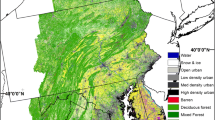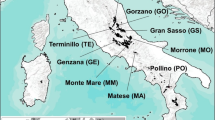Abstract
We examined the use of coarse resolution land cover data (USGS LUDA) to accurately discriminate ecoregions and landscape-scale features important to biodiversity monitoring and management. We used land cover composition and landscape indices, correlation and principal components analysis, and comparison with finer-grained Landsat TM data, to assess how well LUDA data discriminate changing patterns across an agriculture-forest gradient in Minnesota, U.S.A. We found LUDA data to be most accurate at general class levels of agriculture and forest dominance (Anderson Level I), but in consistent and limited in ecotonal areas of the gradient and within forested portions of the study region at finer classes (Anderson Level II).
We expected LUDA to over-represent major (matrix) cover types and under-represent minor types, but this was not consistent with all classes. 1) Land cover types respond individualistically across the gradient, changing landscape grain as well as their spatial distribution and abundance. 2) Agriculture is not over-represented where it is the dominant land cover type, but forest is over-represented where it is dominant. 3) Individual forest types are under-represented in an open land matrix. 4) Within forested areas, mixed deciduous-coniferous forest is over-represented by several orders of magnitude and the separate conifer and hardwood types under-represented. Across gradual, transitional agriculture-forest areas, LUDA cover class dominance changes abruptly in a stair-step fashion. In general, rare cover types that are discrete, such as forest in agriculture or wetlands or water in forest, are more accurately represented than cover classes having lower contrast with the matrix. Northward across the gradient, important changes in the proportions of conifer and deciduous forest mixtures occur at scales not discriminated by LUDA data. Results suggest that finer-grained data are needed to map within-state ecoregions and discriminate important landscape characteristics. LUDA data, or similar coarse resolution data sources, should be used with caution and the biases fully understood before being applied in regional landscape management.
Similar content being viewed by others
References
Albert, D. A. 1995. Regional landscape ecosystems of Michigan, Minnesota, and Wisconsin: A working map and classification. U. S. D. A. Forest Service, North Central Forest Experiment Station. General Technical Report NC-178. St. Paul, MN. 250pp.
Anderson, J. R., E. E. Hardy, J. T. Roach, and R. E. Witmer. 1976. A land use and land cover classification system for use with remote sensor data: U.S. Geological Survey Professional Paper 964, 28 pp.
Askins, R. A., M. J. Philbrick, and D. S. Sugeno. 1987. Relationship between the regional abundance of forest and the composition of forest bird communities. Biological Conservation 39: 129–152.
Bailey, R. G., P. E. Avers, T. King, and W. H. McNab. 1994. Ecoregions and Subregions of the United States. Map. USDA Forest Service.
Bauer, M. E., T. E. Burk, A. R. Ek, P. R. Coppin, S. D. Lime, T. A. Walsh, D. K. Walters, W. Befort, and D. F. Heinzen. 1994. Satellite inventory of Minnesota forest resources. Photogrammetric Engineering and Remote Sensing 60: 287–298.
Brittingham, M. C., and S. A. Temple. 1983. Have cowbirds caused forest songbirds to decline? Bioscience 33: 31–35.
ESRI, Inc. 1990. ARC/INFO User's manual. Environmental Systems Research Institute, Inc. Redlands, California, USA.
Fegeas, R. G., R. W. Claire, S. C. Guptill, K. G. Anderson, and C. H. Hallam. 1983. Land use and land cover digital data. Geological Survey Circular 895-E, US Geological Survey. Reston, VA.
Flather, C. H., L. A, Joyce, and C. A. Bloomgarden. 1994. Species endangerment patterns in the United States. Gen. Tech. Rep. RM-241. USDA Forest Service. Rocky Mountain Forest and Range Experiment Station. 42 pp. Ft. Collins, CO.
Flather, C. H., S. J. Brady, and D.B. Inkley. 1992. Regional habitat appraisals of wildlife communities: a landscape-level evaluation of a resource planning model using avian distribution data. Landscape Ecology 7: 137–147.
Forman, R. T. T., and M. Godron. 1986. Landscape Ecology. Wiley. New York, USA.
Franklin, J. F. 1993. The fundamentals of ecosystem management with application to the Pacific Northwest. Pp. 127–144 in: G. Aplet, J. T. Olson, N. Johnson, and V. A. Sample, eds. Defining sustainable forestry. Island Press, Wash., DC.
Gardner, R. H., B. T. Milne, M. G. Turner, and R. V. O'Neill. 1987. Neutral models for the analysis of broad-scale landscape pattern. Landscape Ecology 1: 19–28.
Green, J. C., and G. J. Niemi. 1980. Birds of the Superior National Forest. US Forest Service, Superior National Forest, Duluth, MN, USA.
Gustafson, E. J., and G. R. Parker. 1992. Relationship between landcover proportion and indices of landscape spatial pattern. Landscape Ecology 7: 101–110.
Hansen, A. J., and D. L. Urban. 1992. Avian response patterns to landscape pattern: the role of species' life histories. Landscape Ecology 7: 163–180.
Harris, L. D. 1984. The fragmented forest: island biogeography theory and the preservation of biotic diversity. Univ. of Chicago Press. Chicago, IL.
Hawrot, R. Y., and G. J. Niemi. Effects of edge type, patch shape, and patch size on avian communities in a mixed conifer-northern hardwood forest. The Auk: in press.
Heinselman, M. L. 1973. Fire in the virgin forests of the boundary waters canoe area, Minnesota. Quaternary Research 3: 329–382.
Hess, G. 1994. Pattern and process in landscape ecology: a commentary. Landscape Ecology 9: 3–5.
Hunsaker, C. T., R. V. O'Neill, B. L. Jackson, S. P. Timmins, D. A. Levine, and D. J. Norton. 1994. Sampling to characterize landscape pattern. Landscape Ecology 9: 207–226.
Iverson, L. R., E. A. Cook, and R. L. Graham. 1994. Regional forest cover estimation via remote sensing: the calibration center concept. Landscape Ecology 9: 159–174.
Iverson, L. R., R. L. Oliver, D. P. Tucker, P. G. Risser, C. D. Burnett, and R. G. Rayburn. 1989. The forest resources of Illinois: an atlas and analysis of spatial and temporal trends. Illinois Natural History Survey Special Publication 11. 181 pp. Champaign, IL.
Krummel, J. R., R. H. Gardner, G. Sugihara, R. V. O'Neill, and P. R. Coleman. 1987. Landscape patterns in a disturbed environment. Oikos 48: 321–324.
Jelinksi, D. E., and J. Wu. 1996. The modifiable area unit problem and implications for landscape ecology. Landscape Ecology 11: 129–140.
Lebart, L., A. Morineau, and K. M. Warwick. 1984. Multivariate descriptive statistical analysis. Wiley. NY, NY.
Loveland, T. R., J. W. Merchant, D. O. Ohlen, and J. F. Brown. 1991. Development of a landcover characteristics database for the conterminous U.S. Photogrammetric Engineering and Remote Sensing 57: 1453–1463.
Ludwig, J. A. and J. F. Reynolds. 1988. Statistical ecology. Wiley Interscience. NY, NY. 337pp.
Mandelbrot, B. B. 1977. The fractal geometry of nature. W. H. Freeman, New York, New York, USA.
Mladenoff, D. J., T. A. Sickley, R. G. Haight, and A. P. Wydeven. 1995. A regional analysis and prediction of favorable gray wolf habitat in the northern Great Lakes region. Conservation Biology 9: 279–294.
Mladenoff, D. J. and G. E. Host. 1994. Ecological perspective: Current and potential applications of remote sensing and GIS for ecosystem analysis. Pp. 219–242 in: Sample, V. A., ed. Remote sensing and GIS in ecosystem management. Island Press, Wash., DC.
Mladenoff, D. J. and J. Pastor. 1993. Sustainable forest ecosystems in the northern hardwood and conifer region: Concepts and management. Pp. 145–180 in: G. Aplet, J. T. Olson, N. Johnson, and V. A. Sample, eds. Defining sustainable forestry. Island Press, Wash., DC.
Mladenoff, D. J., M. A. White, J. Pastor, and T. R. Crow. 1993. Comparing spatial pattern in unaltered old-growth and disturbed forest landscapes. Ecological Applications 3: 294–306.
Moody, A., and C. E. Woodcock. 1994. Scale-dependent errors in the estimation of land-cover proportions: implications for global land-cover data sets. Photogrammetric Engineering and Remote Sensing 60: 585–594.
Niemi, J. R., D. J. Mladenoff, and J. M. Hanowski, A. R. Lima, and M. A. White. Forest fragmentation and bird species distribution on roadside counts in Minnesota and Wisconsin. Submitted manuscript.
O'Neill, R. V., J. R. Krummel, R. H. Gardner, G. Sugihara, B. Jackson, D. L. DeAngelis, B. T. Milne, M. G. Turner, B. Zygmunt, S. W. Christensen, V. H. Dale, and R. L. Graham. 1988. Indices of landscape pattern. Landscape Ecology 1: 153–162.
Pastor, J. and D. J. Mladenoff. 1992. The Southern borealnorthern hardwood border. Pp. 216–240 in H. H. Shugart, R. Leemans, and G. B. Bonan, eds. A systems analysis of the global boreal forest. Cambridge University Press. Cambridge, UK.
Ripple, W. J. 1994. Determining coniferous forest cover and forest fragmentation with NOAA-9 Advanced Very High Resolution Radiometer data. Photogrammetric Engineering and Remote Sensing 60: 533–540.
Senft, R. L., M. B. Coughenour, D. W. Bailey, L. R. Rittenhouse, and O. E. Sala. 1987. Large herbivore foraging and ecological hierarchies. Bioscience 37: 789–799.
Shannon, C. E., and W. Weaver. 1962. The mathematical theory of communication. University of Illinois Press. Urbana, Illinois, USA.
Turner, M. G. 1990. Spatial and temporal analysis of landscape patterns. Landscape Ecology 4:21–30.
Turner, M. G. 1989. Landscape ecology: the effect of pattern on process. Annual Reviews of Ecology and Systematics 20: 171–197.
Turner, M. G., R. V. O'Neill, R. H. Gardner, and B. T. Milne. 1989a. Effect of changing spatial scale on the analysis of landscape pattern. Landscape Ecology 3:153–162.
Turner, M. G., V. H. Dale, and R. H. Gardner. 1989b. Predicting across scales: theory development and testing. Landscape Ecology 3: 245–252.
Turner, M. G. (ed.) 1987. Landscape heterogeneity and disturbance. Springer-Verlag. New York, NY.
US Geological Survey. 1986. Land use and land cover digital data from 1:250,000 and 1:100,000 scale maps. Data user's guide 4. Reston, VA.
Wickham, J. D., R. V. O'Neill, K. H. Riitters, T. G. Wade, and K. B. Jones. 1996. Sensitivity of selected landscape pattern metrics to land-cover misclassification and differences in land-cover composition. Photogrammetric Engineering and Remote Sensing 62: in press.
Wickham, J. D., and K. H. Riitters. 1995. Sensitivity of landscape metrics to pixel size. International Journal of Remote Sensing 16: 3585–3594.
Wolter, P. T., D. J. Mladenoff, G. E. Host, and T. R. Crow. 1995. Improved forest classification in the Lake States using multitemporal Landsat imagery. Photogrammetric Engineering and Remote Sensing 61: 1129–1143.
Wolter, P. T., and D. J. Mladenoff. 1995. Improved forest cover classifications of northeastern Minnesota using multi-temporal Landsat data and National Wetlands Inventory data. Abstract. In proceedings 10th Annual Landscape Ecology Symposium. Minneapolis, MN. p. 183.
Zhu, Z., and D. L. Evans. 1994. U.S. forest types and predicted percent forest cover from AVHRR data. Photogrammetric Engineering and Remote Sensing 60: 525–5321.
Author information
Authors and Affiliations
Rights and permissions
About this article
Cite this article
Mladenoff, D.J., Niemi, G.J. & White, M.A. Effects of changing landscape pattern and U. S. G. S. land cover data variability on ecoregion discrimination across a forest-agriculture gradient. Landscape Ecology 12, 379–396 (1997). https://doi.org/10.1023/A:1007974800297
Issue Date:
DOI: https://doi.org/10.1023/A:1007974800297




